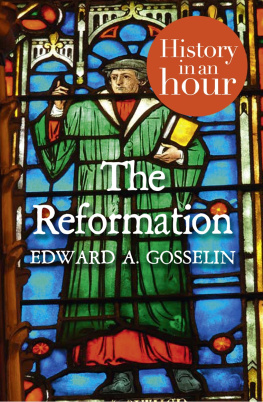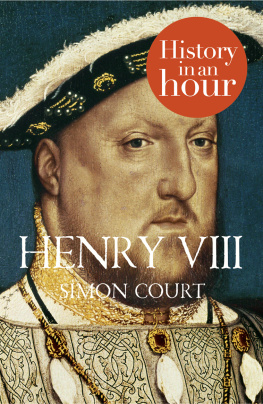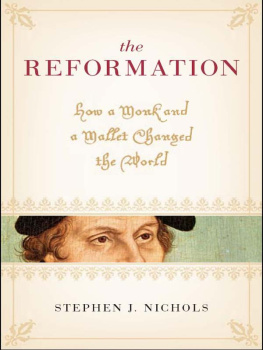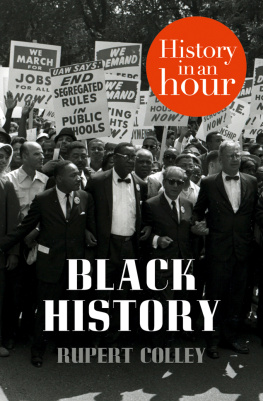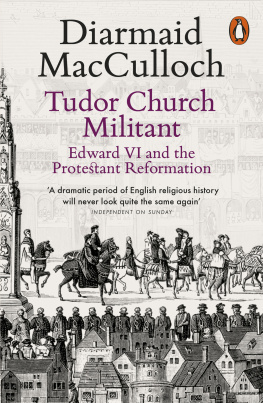THE REFORMATION
History in an Hour
Edward A. Gosselin
History in an Hour is a series of ebooks to help the reader learn the basic facts of a given subject area. Everything you need to know is presented in a straightforward narrative and in chronological order. No embedded links to divert your attention, nor a daunting book of 600 pages with a 35-page introduction. Just straight in, to the point, sixty minutes, done. Then, having absorbed the basics, you may feel inspired to explore further.
Give yourself sixty minutes and see what you can learn
To find out more visit http://historyinanhour.com or follow us on twitter: http://twitter.com/historyinanhour
Contents
From the time of St Peter to AD 1521, the Roman Catholic Church was the only official Christian church in western Europe. It provided the only means through which a person could expect to have access to God and gain entry into Heaven. The Church, however, was not immune to corruption, and there had been several attempts to rein in Church leaders who were often distracted from their pastoral duties with more earth-bound interests such as the gathering of power and wealth. Yet the one Church remained intact and unchanged in its teachings and doctrines throughout the Middle Ages into the Renaissance and up to the Reformation.
In the sixteenth century, Martin Luther began his feverish quest for salvation and Church reform, and started an evangelical movement which spread beyond the borders of sixteenth-century Germany. This movement is the first of three distinct developments of the Protestant Reformation. Luthers (and others) evangelical revolution evolved into personal causes for rulers and monarchs, who sought to impose their religious will upon their subjects, and signified a second phase, the Reformation from above. During the Reformations third, confessional (religious wars) period, in which princes, territories and national churches conducted wars of belief, Protestants migrated to and colonized new settlements, and created their own methods of preserving the faith.
The era of the Protestant Reformation begins in 1517 and, by 1648, becomes fully shaped in Europe as a movement embodying several new independent churches, revolutionized systems of belief and geopolitical changes that affected monarchs and their subjects throughout the region. By the mid-seventeenth century, the original one Church had become several different churches without any hope of reuniting.
On 31 October 1517, the 34-year-old German monk, Martin Luther (pictured above c. 1520), posted his condemnation against Roman Catholic theological declarations on the door of Wittenberg Castle Church. Luther therein attacked, among other things, a system of Church-sponsored intercession in exchange for money as a means of getting into Heaven. Described by a contemporary as a man of middle stature, with a voice which combined sharpness and softness, Luther believed in a God who condemns sinful men, without exception, and was consumed by years of self-doubt as to whether he himself would ever get into Heaven.
Martin Luther c.1520, by Lucas Cranach the Elder
The Protestant Reformation, in simple terms, caused a breaking off of many Christians from the original Roman Catholic Church. New churches were formed throughout Europe under the leadership of Luther, Huldreich Zwingli, John Calvin and others. Wars would be fought within and between states over matters of religion, and tens of thousands of Europeans would die in the ensuing conflicts.
Todays relatively harmonious coexistence among the many Protestant churches and sects as well as between Protestantism and Roman Catholicism belies the hatred that existed between and among them all throughout the sixteenth century.
Luthers simple act of nailing his writings to a cathedral door began a change in western Europe of such magnitude that it can only be compared to the Scientific Revolution of the seventeenth century. The invention of Gutenbergs new printing press with movable type (c. 1450) made these two revolutions possible by allowing information and new ideas to spread quickly and far.
Ensuring your salvation for an eternity in Heaven so as to avoid eternity in Hell was as important to a believer in the sixteenth century (whether king or commoner) as getting a good crop or transporting your wool to market. According to the Roman Catholic Church, there could be no entrance into Heaven without the Church and its exclusive sacraments which conferred what is known as sanctifying grace.
Take, for example, King Henry IV of France who on 14 May 1610 was stopped in his carriage on a street in Paris, and stabbed in the chest by an assassin. His companions, although sure he was already dead, covered his wounds as he was rushed back to the palace. Laid out on his bed, a priest put his ear to the kings mouth in order to hear a possible last confession but no sound came from the dead monarchs mouth. The sacrament of Last Rites could not be performed and it was thus possible, although the Church would never pronounce on the issue, that King Henry never made it to heaven.
By the mid-twelfth century, seven sacraments (the outward acts which give inward, divine grace) had been defined canonically, of which five were for the laity and religious alike. All Roman Catholics were baptized soon after birth, removing the Original Sin (which Adam and Eve had committed after their unfortunate encounter with Satan in the Garden of Eden). They could all receive the sacrament of confession from a priest by which their souls were cleansed of sins committed since baptism. All Catholics could then receive communion (the Eucharist or Lords Supper a replication of Christs Last Supper with His Apostles before His crucifixion) from a priest who changed the bread and wine at the celebration of Mass into what was (and is still) believed by Catholics to be: the real Body and Blood of Jesus. They were given the sacrament of confirmation in their teenage years to become adults in and defenders of the Catholic faith. Finally, all Christians could have their souls given a final cleansing, Eucharist, and a last anointing from a priest before death through the sacrament of Extreme Unction.
One of the final two sacraments was for the laity (Marriage) and the other (Holy Orders) for those becoming priests who were then capable of performing the sacrement of Eucharist changing bread and wine into the real Body and Blood of Jesus for Eucharistic communion. After AD 1139, the Church decreed that priests could not marry, thereby circumventing inheritance disputes within the Church and its properties.
Salvation should have been accessible for all sixteenth-century Roman Catholics as long as they received these sacraments and did good works. However, as in the case of Henry IV, death might be sudden, leaving serious or, as they were called, mortal sins unconfessed. If you died with unconfessed mortal sins (for example murder or robbery), you certainly wound up in Hell for eternity. Gods judgement upon your death with unconfessed venial (lesser) sins sent you to Purgatory, the Third Place as Luther called it.
Purgatory was not an eternal abode, but a place where your soul spent an unknown period of time, undergoing a purging of venial sins such as theft, lying or some minor moral offence. Such purgation through fire could last anywhere from a day to the end of the world, and God never gave clues as to how long a soul would stay in Purgatory. The existence of Purgatory became carefully defined through the authority of thirteenth-century Roman Catholic theologians such as Thomas Aquinas. At the Council of Florence (1439), the Roman Catholic Church decreed Purgatory, and believers saw it as a densely populated place which was nearly impossible to avoid.



